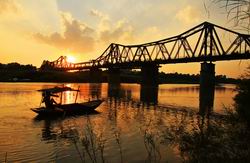Long Bien – a bridge between the past and present
VGP – Long Bien bridge may be seen as a symbol of the courageous capital in the independence wars. The bridge, hence, is not only a traffic-served structure with nice architecture, but also a living historical relic.
 |
Long Bien Bridge is scheduled to be rebuilt or upgraded according to a controversy Transport Ministry plan but architects call it a precious urban heritage of the capital that should be preserved. Photo by Binh Minh
The bridge was built in 1889-1902 by architects Daydé and Pillé of Paris, and opened to traffic in 1903. It was originally 1,800 meters long with a single-track railway in the middle with car and pedestrian lanes on both sides
Long Bien was considered the pride and the symbol of architecture. The bridge helped transport tons of rice from the Northern and Northern Central areas to the Dien Bien Phu battle field and contributed to the victory of Viet Nam army against the French in 1954.
The bridge was severely damaged in several American bombings including the final ones in 1972 due to its critical position at the time as the only bridge across the Red River connecting Hanoi to the main port city of Hai Phong. Rebuilding took place until 1973 and only half of the bridge retained its original shape.
Today trains, mopeds, bicycles and pedestrians use the dilapidated bridge, while all other traffic is diverted to the nearby Chương Dương Bridgeand some newly built bridges: Thanh Tri Bridge,Thang Long Bridge, Vinh Tuy Bridge, and Nhat Tan Bridge.
Many people living and visiting Ha Noi said Long Bien Bridge is the best place to look at the sunrise or the sunset and to take nice photos of alluvial patch.
Many brides and grooms choose Long Bien Bridge as an ideal background for their wedding albums.
Many tourists come here to visit the historical construction and view nice scenery.
Many youngsters, teenagers take photos to keep memories of their youth on the bridge or in the middle of alluvial patch full of green trees.
Many vendors and housewives still come here every afternoon for shopping at an open air market.
By Ngoc Van

